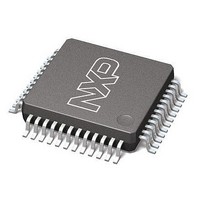LPC11C22FBD48/301,151 NXP Semiconductors, LPC11C22FBD48/301,151 Datasheet - Page 17

LPC11C22FBD48/301,151
Manufacturer Part Number
LPC11C22FBD48/301,151
Description
Microcontrollers (MCU) CAN Transceiver MCU 16K Flash
Manufacturer
NXP Semiconductors
Datasheet
1.LPC11C22FBD48301151.pdf
(62 pages)
Specifications of LPC11C22FBD48/301,151
Processor Series
LPC11Cx2
Core
ARM Cortex-M0
Data Bus Width
32 bit
Program Memory Type
Flash
Program Memory Size
16 KB
Data Ram Size
8 KB
Interface Type
CAN, I2C, SPI, UART
Maximum Clock Frequency
50 MHz
Number Of Programmable I/os
36
Number Of Timers
4
Operating Supply Voltage
3.3 V
Maximum Operating Temperature
+ 85 C
Mounting Style
SMD/SMT
Development Tools By Supplier
OM13012,598
Minimum Operating Temperature
- 40 C
Lead Free Status / Rohs Status
Details
Other names
935294284151
NXP Semiconductors
LPC11CX2_CX4
Product data sheet
7.5.2 Interrupt sources
7.7.1 Features
7.6 IOCONFIG block
7.7 Fast general purpose parallel I/O
Each peripheral device has one interrupt line connected to the NVIC but may have several
interrupt flags. Individual interrupt flags may also represent more than one interrupt
source.
Any GPIO pin (total of 40 pins (LPC11C12/C14) or 36 pins (LPC11C22/C24)) regardless
of the selected function, can be programmed to generate an interrupt on a level, or rising
edge or falling edge, or both.
The IOCONFIG block allows selected pins of the microcontroller to have more than one
function. Configuration registers control the multiplexers to allow connection between the
pin and the on-chip peripherals.
Peripherals should be connected to the appropriate pins prior to being activated and prior
to any related interrupt(s) being enabled. Activity of any enabled peripheral function that is
not mapped to a related pin should be considered undefined.
Device pins that are not connected to a specific peripheral function are controlled by the
GPIO registers. Pins may be dynamically configured as inputs or outputs. Multiple outputs
can be set or cleared in one write operation.
LPC11Cx2/Cx4 use accelerated GPIO functions:
Additionally, any GPIO pin (total of 40 pins (LPC11C12/C14) or 36 pins (LPC11C22/C24))
providing a digital function can be programmed to generate an interrupt on a level, a rising
or falling edge, or both.
•
•
•
•
•
•
•
•
•
Four programmable interrupt priority levels, with hardware priority level masking.
Software interrupt generation.
GPIO registers are a dedicated AHB peripheral so that the fastest possible I/O timing
can be achieved.
Entire port value can be written in one instruction.
Bit level port registers allow a single instruction to set or clear any number of bits in
one write operation.
Direction control of individual bits.
All GPIO pins default to inputs with pull-ups enabled after reset except for the I
true open-drain pins PIO0_4 and PIO0_5.
Pull-up/pull-down resistor configuration can be programmed through the IOCONFIG
block for each GPIO pin (except PIO0_4 and PIO0_5).
All GPIO pins (except PIO0_4 and PIO0_5) are pulled up to 3.3 V (V
pull-up resistor is enabled in the IOCONFIG block.
All information provided in this document is subject to legal disclaimers.
Rev. 3 — 27 June 2011
32-bit ARM Cortex-M0 microcontroller
LPC11Cx2/Cx4
© NXP B.V. 2011. All rights reserved.
DD
= 3.3 V) if their
2
17 of 62
C-bus















